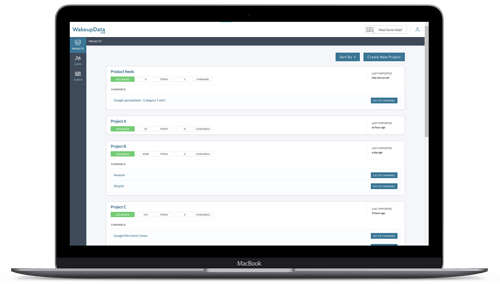Mastering E-Commerce Success: Q&A with Our Customer Success Team Lead
Posted on May 28, 2024 (Last Updated: June 10, 2024)
Welcome to WakeupData, your go-to source for insights into e-commerce feed management.
Today, we're sitting down with Lora, our Customer Success Team Lead, to discuss some of the most relevant and frequently asked questions from our clients. Lora has extensive experience working with our clients daily, offering tips and tricks to manage product data effectively.
You can watch the full interview below.
Q: How important is near real-time data for e-commerce businesses?
Lora: Near real-time data is crucial in today's fast-paced market environments. With hourly updates, we help our clients maintain the most current information on pricing and inventory levels. This allows them to respond swiftly to market changes, such as adjusting prices based on competitors' activity or restocking popular items. Knowing which items are out of stock ensures that clients remain competitive and can capitalize on demand dynamics.
Q: Why is having relevant and up-to-date data important for major events like Black Friday?
Lora: During events like Black Friday, consumer demand spikes unpredictably, and inventory levels fluctuate significantly. Using near real-time data helps businesses adjust their pricing strategies on the fly, capitalize on trends, and manage their inventory more efficiently. This responsiveness not only maximizes sales but also improves customer experience by ensuring that popular products are in stock and competitively priced.
What have we learned from Black Friday 2023?
Q: How do real-time updates affect customer satisfaction?
Lora: Hourly updates enhance customer satisfaction by ensuring that the information shoppers see online is accurate and current. This reduces the likelihood of customer frustration due to out-of-stock products. An unpleasant experience, such as ordering an item only to find out it is unavailable, can damage trust and discourage repeat purchases. By avoiding these situations, businesses can boost loyalty and encourage repeat customers.
Q: What is the impact of images on sales, especially on social media?
Lora: Social media is a very visual channel, and the images used need to be captivating and visually aligned with the branding and messaging of the company. Using consistent visual elements and promotional messages creates a unified brand experience that resonates more effectively with the audience. Our new image editor allows clients to add product data directly to images, making them more informative and appealing.
Q: How can businesses handle large datasets and ensure timely updates?
Laura: For large datasets, we recommend setting up incremental updates. This means only updating certain fields with modified information since the last update, rather than reloading the entire dataset. This approach saves time and minimizes the workload required to manage the data. For example, during high-demand periods like Black Friday, the most critical updates are typically prices and stock levels.
Want to know more - The Risks of Outdated Product Data: How to Stay Competitive
Q: How do we assist clients in fetching and managing their data across multiple channels?
Lora: We offer a feature called data scraping, which scans product pages for any missing data and adds it to the feed. This can include detailed product descriptions, specifications, categories, and updated images. By integrating and enriching the feed with this data, we optimize it for better performance across various channels.
We offer a free feed audit so you can lay back while we inspect your feeds and give your improvement suggestions.
Q: What tools do we offer that are most valued by our clients?
Lora: The tools our clients value the most include our website scraping capabilities and the image transformation tool, especially for social media managers. Additionally, our newest AI tool is incredibly valuable. It can analyze product descriptions, populate crucial information, and automatically categorize products. This saves significant time and resources while optimizing product feeds.
Q: What does the future hold for product feed management?
Laura: The future of product feed management is undoubtedly moving towards greater automation, personalization, and integration with emerging technologies. At Wake Up Data, we are continuously innovating our platform, investing in AI capabilities, and preparing for these changes. Our goal is to provide clients with the most advanced and efficient tools to manage their product data effectively.
Conclusion
In the ever-evolving world of e-commerce, staying ahead requires not just up-to-date data but also the ability to adapt quickly to market changes. As Laura highlighted, the key to success lies in leveraging near real-time updates, optimizing visual content for social media, and using advanced tools like data scraping and AI to enhance product feeds. At Wake Up Data, we are committed to providing innovative solutions that help our clients stay competitive and meet their customers' needs efficiently. With the right strategies and tools, you can turn data management into a powerful advantage for your business.
Stay efficient!
P.S. We are geeky and nerdy and thus love to share knowledge with our audience so do not hesitate to contact us for more information on anything feed-related through our social media channels or contact information.
Book a short meeting with us and let's talk business.







